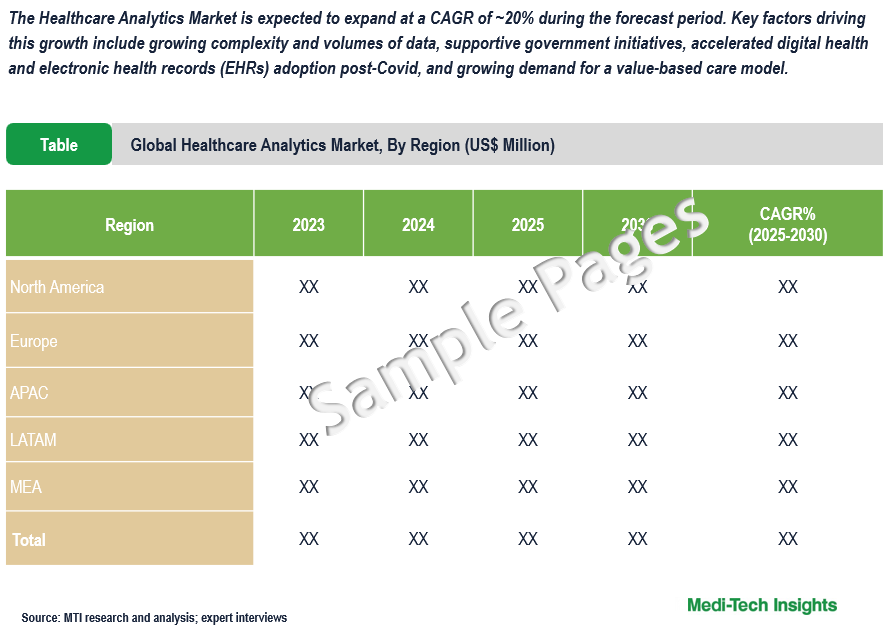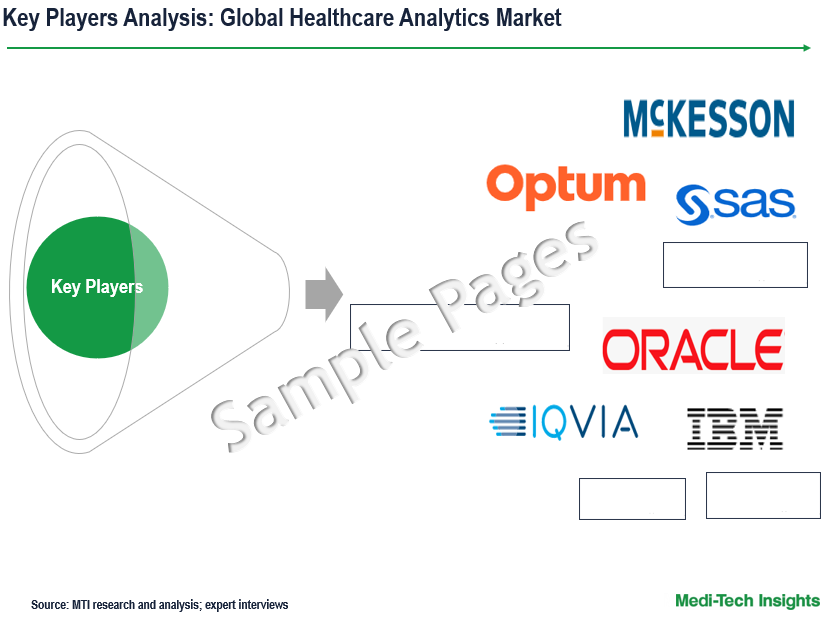
Global Healthcare Analytics Market Size & Trends Report Segmented by Component (Software, Hardware, Services), Type (Predictive, Descriptive, Prescriptive), Application (Clinical, Financial), Delivery Mode (On-premises, Cloud, Web), End-user, & Regional Forecast to 2030
The Healthcare Analytics Market is expected to expand at a CAGR of ~20% during the forecast period. Key factors driving this growth include growing complexity and volumes of data, supportive government initiatives, accelerated digital health and electronic health records (EHRs) adoption post-Covid, rising VC/PE investments, growing demand for a value-based care model, increased use of AI and machine learning in healthcare analytics, and need for cost reduction and operational efficiency in healthcare. To learn more about the research report, download a sample report.
Report Overview
Healthcare analytics is a subset of data analytics that combines real-time and historical data to predict trends, reveal actionable insights, and improve clinical, financial, and operational performance. It involves the use of advanced technologies such as big data, artificial intelligence (AI), machine learning (ML), and predictive analytics to extract actionable insights from various sources, including electronic health records (EHRs), medical imaging, wearable devices, claims data, and population health databases. By leveraging healthcare analytics, providers, payers, and policymakers can enhance clinical care, improve hospital efficiency, detect fraud, and support value-based care models, ultimately driving a smarter and more efficient healthcare ecosystem.
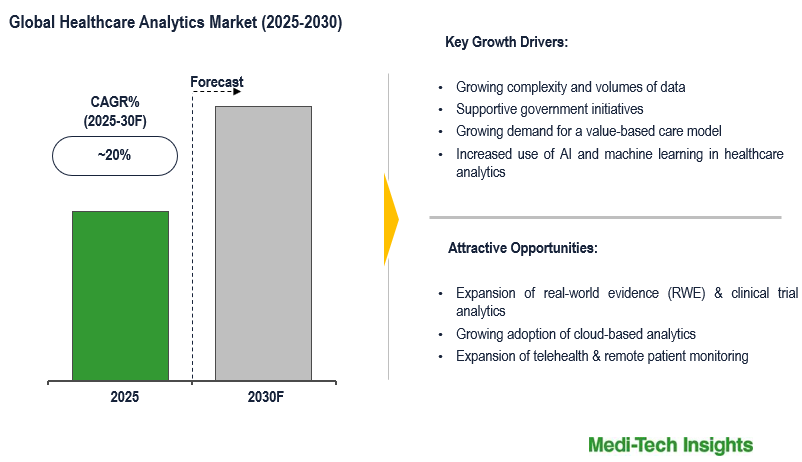
To learn more about this report, download the PDF brochure
Shift towards an evidence-based care model drives market growth
Data and analytics have been central to healthcare for decades. However, a major shift in how data is generated, aggregated, and utilized is being witnessed as the healthcare industry moves from a fee-for-service to a value-based/outcome-based care model. Evidence-based care focuses on using clinical data, real-world evidence (RWE), and predictive analytics to guide medical decisions, moving away from traditional trial-and-error approaches. Advanced analytics help identify treatment patterns, reduce hospital readmissions, and enhance population health management by leveraging vast amounts of patient data from electronic health records (EHRs), wearable devices, and genomics research. Additionally, regulatory initiatives and value-based reimbursement models incentivize healthcare organizations to adopt analytics solutions that enhance the quality of care while reducing costs. As a result, predictive and prescriptive analytics, AI-driven decision support systems, and machine learning algorithms are becoming integral to modern healthcare, fueling the continued expansion of the healthcare analytics market.
Growing focus on advanced analytics tools fuels its demand
Based on our research & interviews with industry experts, currently, healthcare analytics companies derive most of their revenues from descriptive analytics however, increasingly the healthcare providers and payers are implementing predictive and prescriptive analytics. Predictive analytics, powered by AI and machine learning, is transforming patient care by identifying disease risks early and enabling proactive interventions. Meanwhile, prescriptive analytics is optimizing treatment plans and operational workflows, reducing inefficiencies in hospitals and insurance processes. The adoption of big data analytics, cloud-based solutions, and real-time data processing is further enhancing the ability to extract actionable insights from vast healthcare datasets, including electronic health records (EHRs), medical imaging, and wearable device data. As healthcare providers, payers, and pharmaceutical companies continue to embrace automation, AI-driven diagnostics, and population health management tools, the demand for advanced analytics solutions is expected to surge, reshaping the future of healthcare delivery and driving sustained market growth.
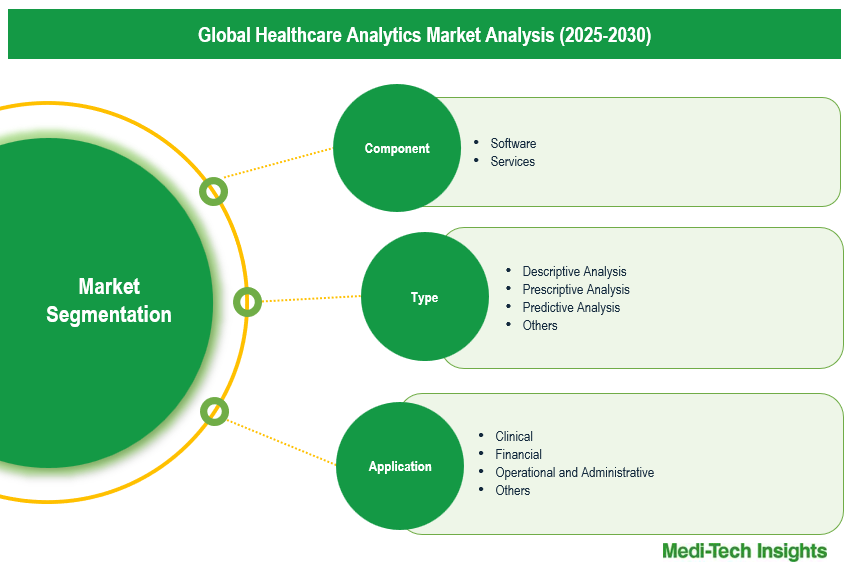
To learn more about this report, download the PDF brochure
Competitive Landscape Analysis
The global healthcare analytics market is marked by the presence of established and emerging market players such as McKesson Corporation; Optum, Inc.; Verisk Analytics Inc.; Elsevier; Medeanalytics Inc.; Truven Health Analytics; Allscripts Healthcare Solutions Inc.; IBM; Cerner Corporation; IQVIA; Oracle; SAS Institute, Inc.; Inovalon; Health Catalyst; SCIO Health Analytics; Cotiviti (formerly Verscend Technologies); CitiusTech; VitreosHealth; Dedalus; Clanwilliam Group; Evolucare; and Clinithink; among others. Some of the key strategies adopted by market players include new product development, strategic partnerships and collaborations, and investments.
Report Scope
| Report Metric | Details |
| Base Year Considered | 2024 |
| Historical Data | 2023 - 2024 |
| Forecast Period | 2025 - 2030 |
| Growth Rate | ~20% |
| Market Drivers |
|
| Attractive Opportunities |
|
| Segment Scope | Component, Type, Application, Delivery Mode, and End User |
| Regional Scope |
|
| Key Companies Mapped | McKesson Corporation; Optum, Inc.; Verisk Analytics Inc.; Elsevier; Medeanalytics Inc.; Truven Health Analytics; Allscripts Healthcare Solutions Inc.; IBM; Cerner Corporation; IQVIA; Oracle; SAS Institute, Inc.; Inovalon; Health Catalyst; SCIO Health Analytics; Cotiviti (formerly Verscend Technologies); CitiusTech; VitreosHealth; Dedalus; Clanwilliam Group; Evolucare; and Clinithink |
| Report Highlights | Market Size & Forecast, Growth Drivers & Restraints, Trends, Competitive Analysis |
Global Healthcare Analytics Market Segmentation
This report by Medi-Tech Insights provides the size of the global healthcare analytics market at the regional- and country-level from 2023 to 2030. The report further segments the market based on component, type, application, delivery mode, and end user.
Market Size & Forecast (2023-2030), By Component, USD Million
- Software
- Services
Market Size & Forecast (2023-2030), By Type, USD Million
- Descriptive Analysis
- Prescriptive Analysis
- Predictive Analysis
- Others
Market Size & Forecast (2023-2030), By Application, USD Million
- Clinical
- Financial
- Operational and Administrative
- Others
Market Size & Forecast (2023-2030), By Delivery Mode, USD Million
- On-premises
- Cloud-based
- Web-hosted
Market Size & Forecast (2023-2030), By End User, USD Million
- Life Sciences Companies
- Healthcare Payers
- Healthcare Providers
- Others
Market Size & Forecast (2023-2030), By Region, USD Million
- North America
- US
- Canada
- Europe
- UK
- Germany
- France
- Italy
- Spain
- Rest of Europe
- Asia Pacific
- China
- India
- Japan
- Rest of Asia Pacific
- Latin America
- Middle East & Africa
Key Strategic Questions Addressed
- What is the market size & forecast of the healthcare analytics market?
- What are the historical, present, and forecasted market shares and growth rates of various segments and sub-segments of the healthcare analytics market?
- What are the key trends defining the market?
- What are the major factors impacting the market?
- What are the opportunities prevailing in the market?
- Which region has the highest share in the global market? Which region is expected to witness the highest growth rate in the next 5 years?
- Who are the major players operating in the market?
- What are the key strategies adopted by players?
- Introduction
- Introduction
- Market Scope
- Market Definition
- Segments Covered
- Regional Segmentation
- Research Timeframe
- Currency Considered
- Study Limitations
- Stakeholders
- List of Abbreviations
- Key Conferences and Events (2025-2026)
- Research Methodology
- Secondary Research
- Primary Research
- Market Estimation
- Bottom-Up Approach
- Top-Down Approach
- Market Forecasting
- Executive Summary
- Healthcare Analytics Market Snapshot (2025-2030)
- Segment Overview
- Regional Snapshot
- Competitive Insights
- Market Overview
- Market Dynamics
- Drivers
- Growing complexity and volumes of data
- Supportive government initiatives
- Accelerated digital health and electronic health records (EHRs) adoption post-Covid
- Rising VC/PE investments
- Growing demand for a value-based care model
- Increased use of AI and machine learning in healthcare analytics
- Restraints
- Healthcare data security and patient privacy issues
- Unstructured/fragmented data
- Interoperability and data science skills gap
- Opportunities
- Expansion of real-world evidence (RWE) & clinical trial analytics
- Growing adoption of cloud-based analytics
- Expansion of telehealth & remote patient monitoring
- Key Market Trends
- Rising demand for predictive & prescriptive analytics
- Growing adoption of blockchain for the secure health data exchange
- Growth of augmented & virtual reality in healthcare analytics
- Unmet Market Needs
- Industry Speaks
- Global Healthcare Analytics Market Size & Forecast (2023-2030), By Component, USD Million
- Introduction
- Software
- Services
- Global Healthcare Analytics Market Size & Forecast (2023-2030), By Type, USD Million
- Introduction
- Descriptive Analysis
- Prescriptive Analysis
- Predictive Analysis
- Others
- Global Healthcare Analytics Market Size & Forecast (2023-2030), By Application, USD Million
- Introduction
- Clinical
- Financial
- Operational and Administrative
- Others
- Global Healthcare Analytics Market Size & Forecast (2023-2030), By Delivery Mode, USD Million
- Introduction
- On-premises
- Cloud-based
- Web-hosted
- Global Healthcare Analytics Market Size & Forecast (2023-2030), By End User, USD Million
- Introduction
- Life Sciences Companies
- Healthcare Payers
- Healthcare Providers
- Others
- Global Healthcare Analytics Market Size & Forecast (2023-2030), By Region, USD Million
- Introduction
- North America Healthcare Analytics Market Size & Forecast (2023-2030), By Country, USD Million
- US
- Market Size & Forecast, By Component (USD Million)
- Market Size & Forecast, By Type (USD Million)
- Market Size & Forecast, By Application (USD Million)
- Market Size & Forecast, By Delivery Mode (USD Million)
- Market Size & Forecast, By End User (USD Million)
- Canada
- Market Size & Forecast, By Component (USD Million)
- Market Size & Forecast, By Type (USD Million)
- Market Size & Forecast, By Application (USD Million)
- Market Size & Forecast, By Delivery Mode (USD Million)
- Market Size & Forecast, By End User (USD Million)
- US
- Europe Healthcare Analytics Market Size & Forecast (2023-2030), By Country, USD Million
- UK
- Market Size & Forecast, By Component (USD Million)
- Market Size & Forecast, By Type (USD Million)
- Market Size & Forecast, By Application (USD Million)
- Market Size & Forecast, By Delivery Mode (USD Million)
- Market Size & Forecast, By End User (USD Million)
- Germany
- Market Size & Forecast, By Component (USD Million)
- Market Size & Forecast, By Type (USD Million)
- Market Size & Forecast, By Application (USD Million)
- Market Size & Forecast, By Delivery Mode (USD Million)
- Market Size & Forecast, By End User (USD Million)
- France
- Market Size & Forecast, By Component (USD Million)
- Market Size & Forecast, By Type (USD Million)
- Market Size & Forecast, By Application (USD Million)
- Market Size & Forecast, By Delivery Mode (USD Million)
- Market Size & Forecast, By End User (USD Million)
- Italy
- Market Size & Forecast, By Component (USD Million)
- Market Size & Forecast, By Type (USD Million)
- Market Size & Forecast, By Application (USD Million)
- Market Size & Forecast, By Delivery Mode (USD Million)
- Market Size & Forecast, By End User (USD Million)
- Spain
- Market Size & Forecast, By Component (USD Million)
- Market Size & Forecast, By Type (USD Million)
- Market Size & Forecast, By Application (USD Million)
- Market Size & Forecast, By Delivery Mode (USD Million)
- Market Size & Forecast, By End User (USD Million)
- Rest of Europe
- Market Size & Forecast, By Component (USD Million)
- Market Size & Forecast, By Type (USD Million)
- Market Size & Forecast, By Application (USD Million)
- Market Size & Forecast, By Delivery Mode (USD Million)
- Market Size & Forecast, By End User (USD Million)
- UK
- Asia Pacific (APAC) Healthcare Analytics Market Size & Forecast (2023-2030), By Country, USD Million
- China
- Market Size & Forecast, By Component (USD Million)
- Market Size & Forecast, By Type (USD Million)
- Market Size & Forecast, By Application (USD Million)
- Market Size & Forecast, By Delivery Mode (USD Million)
- Market Size & Forecast, By End User (USD Million)
- Japan
- Market Size & Forecast, By Component (USD Million)
- Market Size & Forecast, By Type (USD Million)
- Market Size & Forecast, By Application (USD Million)
- Market Size & Forecast, By Delivery Mode (USD Million)
- Market Size & Forecast, By End User (USD Million)
- India
- Market Size & Forecast, By Component (USD Million)
- Market Size & Forecast, By Type (USD Million)
- Market Size & Forecast, By Application (USD Million)
- Market Size & Forecast, By Delivery Mode (USD Million)
- Market Size & Forecast, By End User (USD Million)
- Rest of Asia Pacific
- Market Size & Forecast, By Component (USD Million)
- Market Size & Forecast, By Type (USD Million)
- Market Size & Forecast, By Application (USD Million)
- Market Size & Forecast, By Delivery Mode (USD Million)
- Market Size & Forecast, By End User (USD Million)
- China
- Latin America (LATAM) Healthcare Analytics Market Size & Forecast (2023-2030), USD Million
- Market Size & Forecast, By Component (USD Million)
- Market Size & Forecast, By Type (USD Million)
- Market Size & Forecast, By Application (USD Million)
- Market Size & Forecast, By Delivery Mode (USD Million)
- Market Size & Forecast, By End User (USD Million)
- Middle East & Africa (MEA) Healthcare Analytics Market Size & Forecast (2023-2030), USD Million
- Market Size & Forecast, By Component (USD Million)
- Market Size & Forecast, By Type (USD Million)
- Market Size & Forecast, By Application (USD Million)
- Market Size & Forecast, By Delivery Mode (USD Million)
- Market Size & Forecast, By End User (USD Million)
- Competitive Landscape
- Key Players and their Competitive Positioning
- Key Player Comparison
- Segment-wise Player Mapping
- Market Share Analysis (2024)
- Company Categorization Matrix
- Dominants/Leaders
- New Entrants
- Emerging Players
- Innovative Players
- Key Strategies Assessment, By Player (2022-2024)
- New Product Launches
- Partnerships, Agreements, & Collaborations
- Mergers & Acquisitions
- Geographic Expansion
- Key Players and their Competitive Positioning
- Company Profiles*
(Business Overview, Financial Performance**, Products Offered, Recent Developments)
- Oracle Corporation
- IBM Corporation
- IQVIA Holdings
- McKesson Corporation
- Optum, Inc.
- Allscripts Healthcare Solutions Inc.
- Cerner Corporation
- SAS Institute, Inc.
- Inovalon
- CitiusTech
- Other Prominent Players
Note: *Indicative list
**For listed companies
The study has been compiled based on extensive primary and secondary research.
Secondary Research (Indicative List)
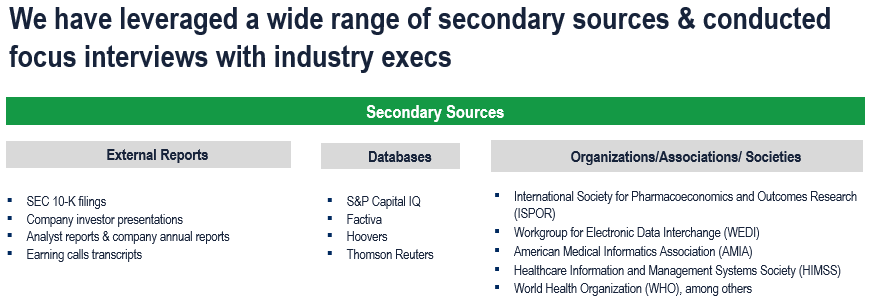
Primary Research
To validate research findings (market size & forecasts, market segmentation, market dynamics, competitive landscape, key industry trends, etc.), extensive primary interviews were conducted with both supply and demand-side stakeholders.
Supply Side Stakeholders:
- Senior Management Level: CEOs, Presidents, Vice-Presidents, Directors, Chief Technology Officers, Chief Commercial Officers
- Mid-Management Level: Product Managers, Sales Managers, Brand Managers, R&D Managers, Business Development Managers, Consultants
Demand Side Stakeholders:
- Stakeholders from Healthcare Companies (Pharmaceutical, Biopharmaceutical, Medical Devices), Healthcare Payers, Healthcare Providers, and Others
Breakdown of Primary Interviews

Market Size Estimation
Both ‘Top-Down & Bottom-Up Approaches’ were used to derive market size estimates and forecasts.
Data Triangulation
Research findings derived through secondary sources & internal analysis were validated with Primary Interviews, the Internal Knowledge Repository, and the Company’s Sales Data.

